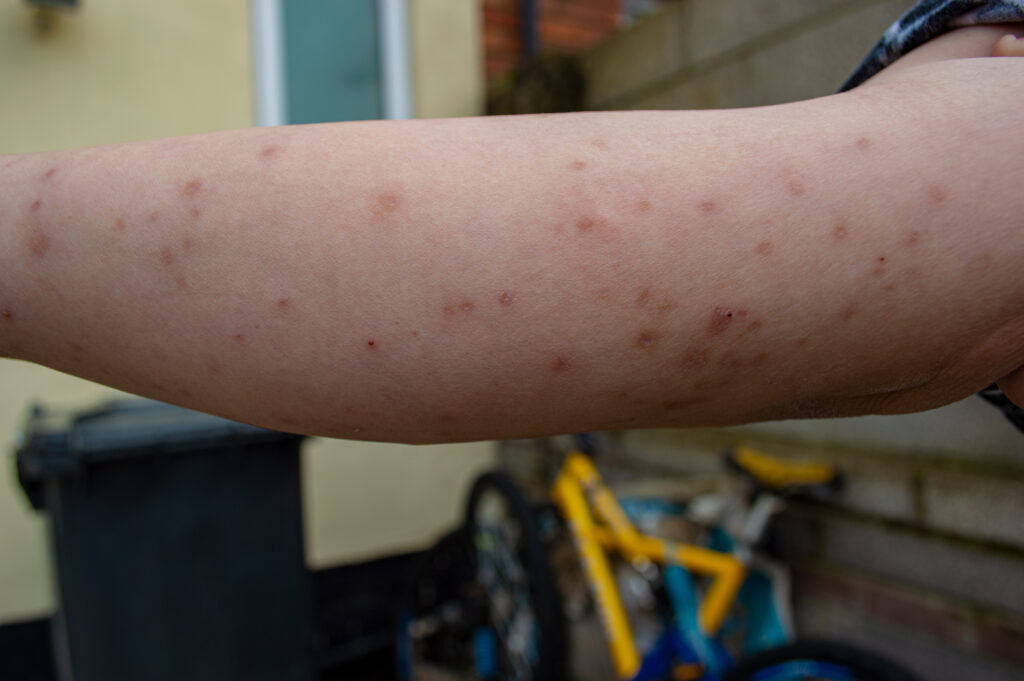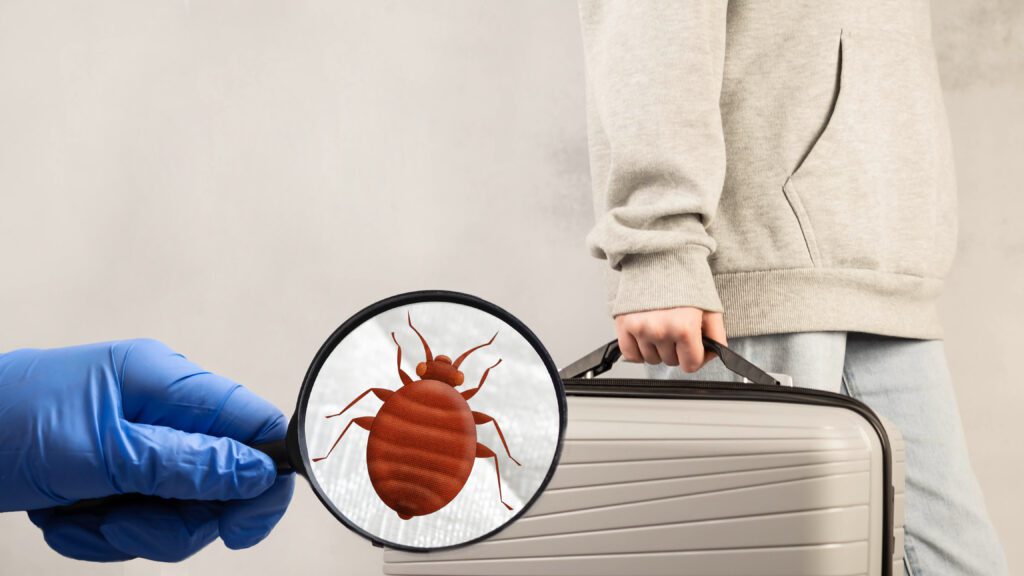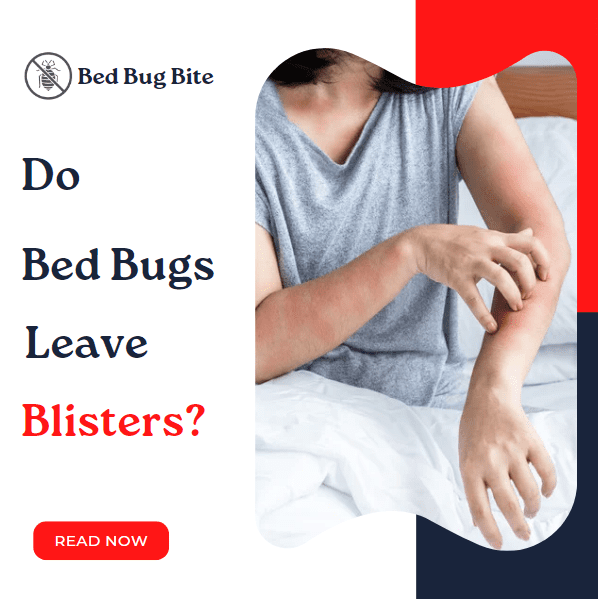Introduction: The Bed Bug Menace
Welcome to our comprehensive guide on a question that many of you have been pondering: “Do Bed Bugs Leave Blisters?” As the go-to source for all things bed bug, we dive deep into understanding these tiny pests that sneak into our beds and disrupt our peace. Bed bugs, known scientifically as Cimex lectularius, have coexisted with humans for thousands of years. Their favorite habitat? Anywhere close to humans, where they can feed unnoticed, usually while we sleep. ….Click now to read about bed bug bites!
Bed bugs are not just a nuisance; their bites can lead to various skin reactions. A common query we encounter is whether these bites can cause blisters. This is a valid concern, given the discomfort and potential for infection associated with blistering. To shed light on this, it’s essential to understand how bed bugs operate. These nocturnal creatures feed on human blood, using a painless bite that often goes undetected until after the fact.
The severity of the reaction to a bed bug bite varies from person to person. While some may experience minor redness or itching, others might notice more severe reactions, including blister-like symptoms. According to the Centers for Disease Control and Prevention (CDC), bed bug bites can sometimes manifest as swollen red spots that may itch or cause a burning sensation. For some individuals, this can escalate into blisters or hives.
Armed with this knowledge, our journey into the world of bed bugs and their impacts on our skin has just begun. Our goal is to equip you with the understanding and tools needed to identify, prevent, and treat bed bug infestations effectively. Stay vigilant, and remember, knowledge is your best defense against these hidden invaders.
Understanding Bed Bug Bites

Diving deeper into the realm of bed bug encounters, it becomes crucial to grasp the nature of bed bug bites and their typical manifestations on human skin. When bed bugs feed, they inject saliva into the skin, which contains anticoagulants and anesthetics, allowing them to feed without waking their host. This unique feeding mechanism is what leads to the varied reactions observed in bite victims.
How Bed Bugs Feed
Bed bugs are strategic feeders. They prefer to dine while their hosts are asleep, making their meals both secretive and uninterrupted. Using their elongated beak, they pierce the skin and draw blood for about 3-10 minutes. Remarkably, their saliva is designed to prevent clotting and ensure a smooth feeding process.
Typical Reactions to Bed Bug Bites
The body’s response to bed bug bites can range significantly among individuals. While some may not notice any signs, others might develop red, itchy welts. These reactions are the body’s response to the proteins found in bed bug saliva. It’s important to note that the severity and timing of these reactions can vary. With some appearing immediately and others taking days to manifest.
Factors Influencing the Severity of Bite Reactions
Several factors can affect how one’s body reacts to bed bug bites. Genetics play a role in determining sensitivity to the bites, with some people more prone to severe reactions than others. The frequency of exposure also influences the body’s response. With repeated bites often leading to heightened sensitivity or, conversely, desensitization over time.
Understanding the dynamics of bed bug feeding habits and the body’s response to their bites is crucial in identifying and addressing bed bug infestations. Recognizing the signs and symptoms is the first step towards ensuring prompt and effective treatment, minimizing discomfort, and preventing further spread.
The Truth About Bed Bugs and Blisters
Addressing the pressing question of whether bed bugs can indeed leave blisters. It’s vital to explore the intersection of bed bug bites and our body’s reaction to them. While not all bed bug bites result in blisters. There are instances where these pests can cause blister-like symptoms on the skin. This condition largely depends on the individual’s reaction to the bites and the severity of the infestation.
Explanation of What Blisters Are
Blisters are small pockets of fluid that form on the skin’s surface, usually as a result of damage or irritation. They can be filled with plasma, blood, or pus, depending on the cause of the blister. While typically associated with burns, allergic reactions, and friction, blisters can also emerge from insect bites. Including those from bed bugs, as a severe allergic reaction.
Can Bed Bugs Cause Blisters?
The straightforward answer is yes, bed bugs can cause blisters in some individuals. These reactions occur when the body’s immune system responds aggressively to the proteins in bed bug saliva, resulting in inflammation and fluid build-up beneath the skin. However, it’s important to note that this is not the most common reaction and tends to occur in cases of more severe sensitivity or allergic responses.
Personal Accounts and Studies
Documented cases and research studies have shed light on the range of reactions bed bug bites can provoke. For instance, a study highlighted in the Journal of Insect Science (Vol. 17, Issue 1) delves into the dermatological reactions to bed bug bites, confirming that while most reactions are mild, severe responses such as blisters and intense itching can occur, particularly in sensitive individuals or those with repeated exposure.
This exploration into the link between bed bugs and blisters underscores the importance of awareness and prevention. Recognizing the potential severity of bed bug bites and the reactions they can provoke is a crucial step in managing and mitigating the impacts of an infestation. Whether you’re dealing with a minor annoyance or a more serious reaction, understanding the nature of these bites is key to seeking appropriate treatment and preventing future occurrences.
Identifying Bed Bug Bites and Their Symptoms
Navigating the often confusing landscape of insect bites can be daunting, especially when trying to pinpoint the culprit behind your discomfort. Bed bug bites have distinctive characteristics that set them apart from other insect bites. Recognizing these signs is crucial for effective identification and subsequent action. Understanding the nuances of bed bug bites and their symptoms equips you with the knowledge to respond appropriately.
Visual Characteristics of Bed Bug Bites
Bed bug bites often appear as small, red, and sometimes swollen spots on the skin. These bites frequently occur in a line or cluster, a pattern resulting from the bed bug’s feeding habits. Unlike mosquito bites, which are more randomly placed, bed bug bites are methodical, reflecting the pest’s movement across the skin.
Differentiating Between Bed Bug Bites and Other Insect Bites
Distinguishing bed bug bites from those of other insects is key to effective diagnosis and treatment. For instance, flea bites are typically found around the ankles or legs and have a central red spot. Mosquito bites, on the other hand, are more isolated and tend to swell significantly. Bed bug bites, with their linear or clustered arrangement, often emerge on exposed skin areas during sleep, such as the arms, neck, and face.
Signs That Your Bites May Be From Bed Bugs
Several indicators suggest that bed bugs might be the source of your bites. If you notice bites after waking up, which were not present the night before, bed bugs could be the culprits. The presence of dark or reddish stains on your bedding—indicative of bed bug fecal matter—or the sighting of the bugs themselves, confirms their presence. Additionally, a musty odor in your sleeping area can also be a telltale sign of a bed bug infestation.
Identifying bed bug bites is the first step in addressing an infestation. By familiarizing yourself with the visual characteristics and symptoms of these bites, you can better differentiate them from other insect bites. This knowledge not only aids in early detection but also informs your approach to treatment and prevention, ensuring a swift and effective response to these unwelcome guests.
Prevention: Keeping Bed Bugs at Bay
Prevention is paramount when it comes to controlling bed bug infestations. Implementing proactive measures can significantly reduce the risk of bed bugs making a home in your living space. By understanding and applying effective prevention strategies, you can protect yourself, your family, and your home from the distress and discomfort bed bugs cause. Below, we detail essential steps for keeping these pests at bay.
Regular Inspection of Sleeping Areas
Conducting routine checks of mattresses, bed frames, and nearby furniture for signs of bed bugs is crucial. Look for small, brownish insects, eggs, or shed skins, as well as the telltale reddish-brown spots on bedding that indicate their presence. Early detection is key to preventing widespread infestation.
Tips for Avoiding Bed Bugs While Traveling

Travel often presents opportunities for bed bugs to hitch a ride on your belongings. To avoid this, inspect hotel room beds, furniture, and luggage stands upon arrival. Utilize luggage protectors and keep your bags closed when not in use. Upon returning home, launder all clothes at high temperatures and vacuum your luggage before storing it.
Preventive Measures for Your Home
Maintaining a clutter-free environment can reduce hiding spots for bed bugs. Use protective covers designed to keep bed bugs out of mattresses and box springs. Seal cracks and crevices in walls and floors, and regularly vacuum your home to remove any potential bed bugs or eggs. Educating yourself and household members about these pests and their prevention can also form a strong defense against them.
By incorporating these prevention strategies into your daily and travel routines, you can significantly lower the chances of a bed bug infestation. Vigilance, combined with regular maintenance and cleanliness, creates an environment that is inhospitable to bed bugs, safeguarding your home and providing peace of mind.
Treatment Options for Bed Bug Bites
When it comes to bed bug bites, understanding the array of treatment options available can significantly alleviate the discomfort and potential skin complications these pests cause. Whether you’re dealing with a mild itch or more severe reactions, there are both home remedies and medical treatments that can provide relief. Here, we explore effective methods to treat bed bug bites, emphasizing the importance of addressing symptoms promptly to prevent infection and promote healing.
Home Remedies to Alleviate Itching and Discomfort
For immediate relief from the itchiness and discomfort of bed bug bites, several home remedies can be quite effective. Applying a cold compress to the affected area can reduce swelling and numb the itch. Calamine lotion or a baking soda and water paste can also provide soothing relief when applied to the bites. Additionally, over-the-counter antihistamines can help manage the allergic reaction and reduce itching.
When to Seek Medical Attention
While most bed bug bites can be treated at home, certain conditions warrant professional medical advice. If you experience severe allergic reactions, such as difficulty breathing, swelling of the face or lips, or blistering, seek medical attention immediately. Infections, indicated by increased pain, swelling, warmth, or pus around the bite, also require a doctor’s care.
Long-Term Solutions for Bed Bug Infestations
Addressing the root cause of bed bug bites, the infestation itself, is crucial for preventing future bites. Professional extermination is often the most effective way to eliminate bed bugs from your home. In conjunction with professional help, maintaining a clean and clutter-free environment and adhering to preventive measures can help keep these pests at bay.
Treating bed bug bites effectively involves a combination of immediate care to alleviate symptoms and long-term strategies to address the infestation. By employing these methods, individuals can not only find relief from the discomfort of bed bug bites but also take proactive steps towards eliminating these pests from their living spaces, ensuring a healthier, bed bug-free environment.
Dealing with Bed Bugs: Professional and DIY Solutions
Combating bed bugs requires a well-thought-out strategy that might involve professional extermination services or do-it-yourself (DIY) approaches, depending on the severity of the infestation. The key to effective control lies in understanding the advantages and limitations of each method, ensuring that the chosen solution adequately addresses the problem. In this section, we explore both professional and DIY solutions for dealing with bed bugs, aiming to equip you with the knowledge to make informed decisions.
When to Call a Professional Exterminator
Recognizing when to seek help from a professional exterminator is crucial in the battle against bed bugs. Large or persistent infestations often necessitate professional intervention. Exterminators bring expertise, experience, and specialized equipment to effectively eliminate bed bugs. If you’ve attempted DIY methods without success, or if the infestation is widespread, it’s time to call in the professionals. They can implement comprehensive treatment plans that include chemical and non-chemical methods, ensuring the eradication of bed bugs at all life stages.
Do-it-Yourself (DIY) Methods for Controlling Bed Bugs
For smaller infestations, or as a preventive measure, there are several DIY methods that can be effective. These include thoroughly cleaning and vacuuming the affected areas, using bed bug-proof mattress encasements, and applying diatomaceous earth or other approved insecticides designed for bed bug control. Heat treatment, such as washing and drying bedding and clothing at high temperatures, can also be effective. However, it’s important to proceed with caution, as improper use of insecticides can be harmful to health and may not effectively eliminate the bed bugs.
Evaluating the Effectiveness of Treatment Options
Whether opting for professional extermination or a DIY approach, monitoring the effectiveness of the treatment is essential. Continuous inspection and being vigilant for signs of bed bugs will help assess whether the methods are working or if further action is needed. It’s often necessary to repeat treatments to fully eradicate bed bugs due to their resilience and ability to hide in hard-to-reach places.
Dealing with bed bugs can be a challenging and often frustrating endeavor. However, by carefully considering the scale of the infestation and choosing the appropriate method of control, you can effectively manage and ultimately eliminate bed bugs from your home. Whether through professional extermination or diligent DIY efforts, the goal is to achieve a bed bug-free environment, restoring peace and comfort to your living space.
Conclusion: Staying Vigilant Against Bed Bugs
In conclusion, addressing the question of whether bed bugs leave blisters involves a multifaceted understanding of these persistent pests and their impact on human skin. While not all bed bug bites result in blisters, it’s important to recognize that severe reactions, including blistering, can occur in sensitive individuals. By familiarizing yourself with the signs and symptoms of bed bug bites, implementing preventive measures, and knowing how to effectively treat bites, you can better protect yourself and your home from the distress bed bugs cause. Remember, early detection and prompt action are key in controlling infestations and minimizing the risk of complications.
Additional Resources:
For further information on bed bugs and related topics, consider exploring the following reputable resources:
– Centers for Disease Control and Prevention (CDC): The CDC offers comprehensive guidance on bed bug identification, prevention, and control.
– Environmental Protection Agency (EPA): The EPA provides valuable resources on bed bug management, including registered pesticides for bed bug control.
– National Pest Management Association (NPMA): The NPMA offers tips and advice on bed bug prevention and treatment, as well as a directory of licensed pest management professionals.
By utilizing these resources and staying informed, you can become better equipped to tackle bed bug issues and maintain a healthy, pest-free living environment. Remember, knowledge is your greatest tool in the fight against bed bugs.




